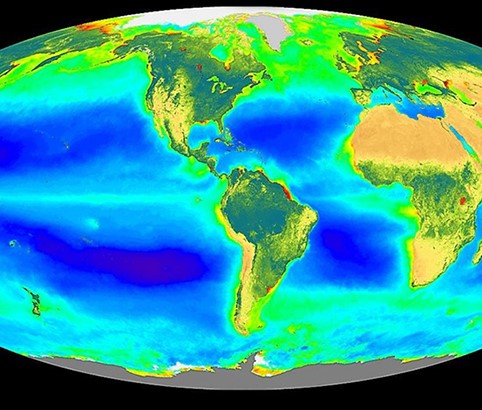Module 8: Photosynthesis
Section outline
-
 Module 8 explores Photosynthesis, the most essential and vital process for the evolution of terrestrial life on earth. Living organisms that evolved to breathe oxygen and gain energy through cellular respiration can only do so as a result of the production of oxygen that is a byproduct of the process of photosynthesis. Without plants there would be no oxygen and no form of energy for many living organisms from butterflies and bumble bees, to hares, horses, and humans. Plants are producers and the basis of foodwebs. Photosynthesis happens deep inside of plants in the chloroplasts of the plant cells. Through absorption of energy from sunlight in combination with carbon dioxide and water, plants produce much needed energy in the form of the carbohydrate molecule glucose and a byproduct of this reaction is six molecules of oxygen. Aren't we so very fortunate for the photosynthesis of plants? In this chapter we will learn about the light dependent and light independent reactions involved in photosynthesis. The structures and chemicals involved in the synthesis of carbohydrates. We will explore the electromagnetic spectrum of light and gain a better understanding of how plants absorb this radiant energy and convert it to chemical energy. Plants provide so much beauty and abundance in our natural world. Plants provide flowers for nectar feeding insects and once these flowers are pollinated they produce food in the form of fruits and vegetables for us animals to eat. Natural plant products provide the largest percentage of chemical compounds for the development chemicals used in medicine. Without plants and photosynthesis we would have less than half of the drugs that were developed between 1981-2002. The future of humankind is dependent upon plants and the process of photosynthesis.[Source of plant medicine: Rendy Kartika (Internet Archive version)]
Module 8 explores Photosynthesis, the most essential and vital process for the evolution of terrestrial life on earth. Living organisms that evolved to breathe oxygen and gain energy through cellular respiration can only do so as a result of the production of oxygen that is a byproduct of the process of photosynthesis. Without plants there would be no oxygen and no form of energy for many living organisms from butterflies and bumble bees, to hares, horses, and humans. Plants are producers and the basis of foodwebs. Photosynthesis happens deep inside of plants in the chloroplasts of the plant cells. Through absorption of energy from sunlight in combination with carbon dioxide and water, plants produce much needed energy in the form of the carbohydrate molecule glucose and a byproduct of this reaction is six molecules of oxygen. Aren't we so very fortunate for the photosynthesis of plants? In this chapter we will learn about the light dependent and light independent reactions involved in photosynthesis. The structures and chemicals involved in the synthesis of carbohydrates. We will explore the electromagnetic spectrum of light and gain a better understanding of how plants absorb this radiant energy and convert it to chemical energy. Plants provide so much beauty and abundance in our natural world. Plants provide flowers for nectar feeding insects and once these flowers are pollinated they produce food in the form of fruits and vegetables for us animals to eat. Natural plant products provide the largest percentage of chemical compounds for the development chemicals used in medicine. Without plants and photosynthesis we would have less than half of the drugs that were developed between 1981-2002. The future of humankind is dependent upon plants and the process of photosynthesis.[Source of plant medicine: Rendy Kartika (Internet Archive version)]Image from Biology 2e from OpenStax, licensed under Creative Commons Attribution License v4.0 with the image credit: modification of work by SeaWiFS Project, NASA/Goddard Space Flight Center and ORBIMAGE
Upon completion of this module, you will be able to:- Explain the significance of photosynthesis to other living organisms (Course Outcome #2, #3)
- Describe the main cellular structures involved in photosynthesis (Course Outcome #2, #3)
- Explain the chemical process and identify the substrates and products of photosynthesis (Course Outcome #2, #3)
- Explain how plants absorb energy from sunlight. Identify the cellular structures involved in the light dependent processes of photosynthesis. (Course Outcome #2, #3)
- Describe short and long wavelengths of light (Course Outcome #2, #3)
- Describe how and where photosynthesis takes place within a plant and what pigments are involved (Course Outcome #2, #3)
- Describe the Calvin cycle (Course Outcome #2, #3)
- Define carbon fixation (Course Outcome #2, #3)
- Explain how photosynthesis works in the energy cycle of all living organisms (Course Outcome #2, #3)
To achieve these objectives:
- Read the Module 8 Introduction
- Read and view the materials in the Module 8 Pressbooks book, embedded below by section for the chapter titled Photosynthesis.
- Complete the assignment and discussion forum post and response.
This module's lab activity is the Lab Practical 1, to occur in the lab class [a Plant Transpiration lab is also available below as an alternative]. Slides are available to accompany the class lecture.
Module Pressbooks Resources and Activities
You will find the following resources and activities in this module at the Pressbooks website. Click on the links below to access or complete each item.
- Explain the significance of photosynthesis to other living organisms (Course Outcome #2, #3)
Background Colour
Font Face
Font Kerning
Font Size
Image Visibility
Letter Spacing
Line Height
Link Highlight
Text Colour
